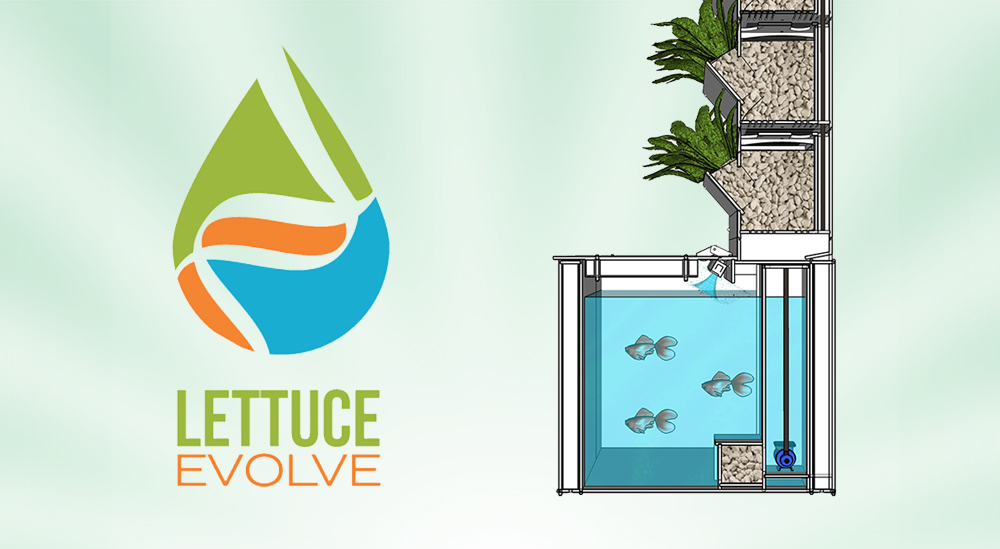A Compact, Self-Watering Garden System that’s Powered by Fish!
Lettuce Evolve is an Aquarium-Powered Garden System that allows you to grow tons of fresh food for you and your family, while saving time, space, and money. The system is extremely versatile; it can be used Aquaponically (with fish), Hydroponically (without fish), or simply fill it up with soil and use it as a vertical …
In First Address In United States, Pope Francis Spends Most Of His Time Talking About Climate Change
In his first public address during his visit to the United States, Pope Francis spent the majority of his time harping on one issue: Climate change.
Speaking before a massive crowd outside the White House Wednesday morning, Pope Francis began his talk by referencing his immigrant heritage, noting, “As the son of an immigrant family, I am happy to be a guest in this country, which was largely built by such families.” He then offered an aside praising the merits of religious liberty, asking the U.S. government to pay heed to the beliefs of American Catholics and “respect their deepest concerns and their right to religious liberty.”
But just three paragraphs into his prepared remarks, Francis pivoted sharply to the another issue near to his heart – the environment.
it seems clear to me also that climate change is a problem which can no longer be left to a future generation.”
“Mr. President, I find it encouraging that you are proposing an initiative for reducing air pollution,” Francis said. “Accepting the urgency, it seems clear to me also that climate change is a problem which can no longer be left to a future generation.”
Francis twice quoted his own encyclical on the environment, a papal document released earlier this year that made headlines because of its bold call for global action on climate change.
“When it comes to the care of our ‘common home’, we are living at a critical moment of history,” he said. “We still have time to make the changes needed to bring about ‘a sustainable and integral development, for we know that things can change.’ Such change demands on our part a serious and responsible recognition not only of the kind of world we may be leaving to our children, but also to the millions of people living under a system which has overlooked them. Our common home has been part of this group of the excluded which cries out to heaven and which today powerfully strikes our homes, our cities and our societies.”
“To use a telling phrase of the Reverend Martin Luther King, we can say that we have defaulted on a promissory note and now is the time to honor it,” Francis added, quoting the famous “I Have A Dream” speech. “We know by faith that ‘the Creator does not abandon us; he never forsakes his loving plan or repents of having created us. Humanity still has the ability to work together in building our common home’. As Christians inspired by this certainty, we wish to commit ourselves to the conscious and responsible care of our common home.”
President Barack Obama, who spoke before Francis, praised the pontiff’s environmentalism.
“Holy Father, you remind us that we have a sacred obligation to protect our planet – God’s magnificent gift to us,” Obama said. “We support your call to all world leaders to support the communities most vulnerable to a changing climate and to come together to preserve our precious world for future generations.”
Francis’ rhetoric isn’t inspiring everyone, however. At least one Catholic Republican – Rep. Paul Gosar (R-AZ) – is boycotting the pope’s speech to Congress on Thursday because he disagree’s with the Holy Father’s stance on climate change.
The Axiom House is a flatpack prefab net-zero “game-changing concept home”
Being an architect can be so frustrating; the established ways are so entrenched, residential building technology is so primitive, it’s all done by hand in the field where the biggest innovation in thirty years was the nail gun replacing the hammer. Meanwhile in the architects offices there are tools that we never dreamed of thirty years ago- computers instead of drafting boards, 3D renderings that spring our of our drawings like magic, and perhaps most importantly of all, the Internet that changes how architects can market what they do.
That’s why the Axiom House, being developed in Kansas City by Acre Designs, is so interesting. Jennifer Dickson is an architect; Andrew Dickson is an industrial designer; together they are trying to turn a house into an industrial product that can be delivered anywhere in a shipping container, for a price that is competitive with conventional construction. They are not thinking like designers, but like a tech startup:
Acre is the very definition of a technology company. We apply scientific knowledge from the fields of architecture, engineering, environmental design, and material and construction science in the most practical way imaginable. We’ve used these practices to create homes that take half the time to build, use a fraction of the resources, and have as little as half the lifetime cost of traditional homes.
The house itself is a flexible 1800 square feet, designed to adapt to its occupants’ life cycles. It’s described as Net Zero energy, producing as much energy as it consumes; it achieves this by being built to near passive house standards so that very little energy is required to operate it in the first place. As they note,
Our homes are 90% more efficient than standard construction to begin with, and we make up the difference with a small solar panel (PV) array. We start with an efficient floor plan and a tight building envelope to prevent air from getting in or out. We use high-efficiency doors, windows, and appliances, take advantage of natural (passive) heating from the sun, and utilize unique heating and cooling solutions.
 © Acre
© Acre
The heating and cooling system is indeed unique; I had to ask for an explanation. In the early days of Passive Houses, many had what are called Earth Tubes, or big pipes buried in the ground that were used as ducts to pre-cool or pre-warm air to the ground temperature, which is about 55°F in Kansas City. But earth tubes proved hugely problematic, delivering condensation, mold, radon and other wonderful things as well as air. Instead, the Axiom house has what they call Passive Geothermal, (PGX) a riff on what others have called brine loops or glycol ground loops. There is a grid of pipes buried in the ground which deliver water at near 55°F to a heat exchanger built into the Heat Recovery Ventilator (HRV) that is required in a house that is so tight. So one gets all the benefits of an earth tube, preheating or precooling the air, without the problems and at a lot lower cost than a fancy ground source heat pump. They appear to work well; in an article by Martin Holladay in Green Building Advisor, a passive house builder called them “amazingly effective.” However Martin, always the skeptic, writes:
Of course, just because a ground loop works, doesn’t mean the system is cost-effective. Many energy experts have speculated that the pump needed to circulate the glycol solution uses almost as much energy as the system collects. The results of one monitoring study indicate that these experts may be right; data gathered in Vermont suggest that the simple payback period for this type of system may be as much as 4,400 years.
 © Acre
© Acre
They are also delivering the tempered water to the radiant floor, and and addition to this system, the house also has a mini-split air source heat pump. Given the near- passive house amount of insulation, tight construction and careful siting, I suspect it won’t get a lot of use.
 © Acre
© Acre
The structure is a flatpack of SIPs, or structural insulated panels. These are a sandwich panel of plywood or OSB board and expanded polystyrene insulation, 10″ thick for the roof and 8″ for the walls. They claim that that it can be built at prices competitive with other houses in Kansas City, running now at $110 to $135 per square foot. How do they do it?
It’s not any one thing, but a combination of strategies, that allows us to achieve this. A few examples:
By offering fixed plans, we can build hours of engineering and design into the base cost of the home. Just like with your car or phone, focused product development helps us deliver a refined, high-performance home that can be repeated again and again. Starting with a right-sized, efficient floor plan has a domino effect: reducing up-front costs, energy demands and system sizes throughout the house. With a lighter load, we can eliminate ductwork, wiring, plumbing runs, and the expensive labor associated with these. With streamlined, repeatable construction, we shave months of labor costs out of each job.
 © Acre
© Acre
Jennifer Dickson tells Metropolis:
We see no reason why architect-designed, highly efficient housing should not be attainable at a reasonable price point. To do that, we are treating this more like a car than a house. With cars, the design effort goes in at the front end, and at the purchase end, the customers do not get a custom product, but they get access to high-end finishes and their choice of features. We think we can leverage buying power by providing a set of well-designed packages.
Having used these same arguments for a decade when I was working in prefab, I am a bit skeptical that they can do that. I found again and again that designs are rarely repeatable, everyone wants to customize, and that customers don’t care about right-sizing, they care about price per square foot. And it’s just so hard to compete with conventional construction, the guy in a pickup with a magnetic sign and a nail gun.
But it is so exciting to see architects and designers trying to innovate in the design of homes and the way that their services and the product are delivered. I am really rooting for them and hope it works. Read more on the website and like any startup looking for money, attention and validation, they are crowdsourcing on Indiegogo.
Please enable JavaScript to view the comments.
Too bad NASA’s plan for space-based solar never happened
It’s always irksome when tech companies talk about their latest “moonshot.” The actual moonshot was one of the most incredible accomplishments of humankind. In 1961, President John F. Kennedy challenged NASA to put someone on the moon by the end of the decade, and NASA, which hadn’t even put someone in orbit yet, was like, “On it, boss,” and then had three people on the moon eight years later. So sorry, Google, even if Google Glass hadn’t flopped, it wouldn’t have been a moonshot, and neither will anything else that comes out of the ” moonshot factory.”
So it’s a real bummer to find out that the agency that today’s most powerful engineers and entrepreneurs so desperately want to emulate had a mind-blowingly awesome plan for a space-based solar factory back in the 70s that never came to fruition. Here’s the scoop from Motherboard:
At the height of the oil crisis in the 1970s, the US government considered building a network of 60 orbiting solar power stations that would beam energy down to Earth. Each geosynchronous satellite, according to this 1981 NASA memo, was to weigh around 35,000 to 50,000 metric tons. The Satellite Power System (SPS) project envisaged building two satellites a year for 30 years.
To get said power stations into orbit, the once-powerful aerospace manufacturing company Rockwell International designed something called a Star-Raker, which, in addition to sounding like something from a sci-fi movie, also would have acted like one:
… The proposed Star-Raker would load its cargo at a regular airport, fly to a spaceport near the equator, fuel up on liquid oxygen and hydrogen, and take off horizontally using its ten supersonic ramjet engines. A 1979 technical paper lays out its potential flight plan: At a cruising altitude of 45,000 feet, the craft would then dive to 37,000 feet to break the sound barrier. At speeds of up to Mach 6, the Star-Raker would jet to an altitude of 29km before the rockets kicked in, propelling it into orbit.
Just to recap: The Star-Raker would have broken the speed of sound by diving seven miles. And the spacecraft would have been making so many regular trips to orbit that it would have essentially been a 747 for space, Motherboard reports.
In terms of feasibility, here’s how one scientist put it at the time:
“The SPS is an attractive, challenging, worthy project, which the aerospace community is well prepared and able to address,” physicist Robert G. Jahn wrote in the foreword to a 1980 SPS feasibility report. “The mature confidence and authority of…[the working groups]…left the clear impression that if some persuasive constellation of purposes…should assign this particular energy strategy a high priority, it could be accomplished.”
Putting solar plants in space would’ve been hard, sure, but this proposal came just ten years after NASA landed Apollo 11 on the moon, so doing seemingly impossible things was kind of their thing. Even if SPS hadn’t happened as planned (and for more details on what exactly that plan was, check out this in-depth look from Wired), there’s no doubt that with the right amount of support and funding, NASA could’ve done something incredible in the clean tech arena.
Today, NASA remains an indispensable source of climate change research. Unfortunately, politicians aren’t as eager to throw money at the agency now that we’re no longer trying to show up the Soviet Union (in fact, the U.S. government is now relying on Russia to take U.S. astronauts up to the International Space Station). And some members of Congress (lookin’ at you, Ted Cruz) have it in their heads that NASA shouldn’t even be doing Earth sciences research in the first place.
We know from the landing of the Curiosity Rover on Mars back in 2012 that NASA still has the ability to inspire and astonish. People geeked out hard over those “seven minutes of terror” and for good reason. Getting that same kind of support behind something that addresses climate change would be exactly what this world needs. If only the one organization proven capable of doing moonshots wasn’t beholden to a bunch of science-hating idiots.
Save the bees with seed bombs
Seed bombs began as a fun and friendly tactic for greening abandoned lots in urban spaces. “Guerrilla gardeners” throw balls of seeds and fertilizer into fenced-off spaces that are otherwise neglected, such as brownfields or land in zoning limbo.
Now, a California company is using seed bombs as a strategy to fight the disappearance of bees. Ei Ei Khin and Chris Burley started Seedles with the aim of spreading bee-friendly wildflowers in neighborhoods around the country. Their goal is to grow 1 billion wildflowers with the help of colorful seed balls, a project they call “Grow the Rainbow.”
Bee populations have been dropping for about a decade. Scientists think there are a number of contributing factors to colony collapse, including the proliferation of certain pesticides, parasites, and even stress. But a decline in natural habitat-along with the loss of bees’ preferred wildflowers -is also a big factor. That’s how Seedles hopes to help, by encouraging people to plant more flowers.
 © Seedles
© Seedles
Seedles creates seed balls with wildflowers native to six different regions of the United States. For example, the Midwest mix may include wild perennial lupine, lemon mint and butterfly weed. The seeds are rolled up with organic compost to fertilize the seeds, and non-toxic color powders to add a bit of fun. The balls can be tossed anywhere you want flowers to grow, and with the help of some rain and sun will start to sprout.
For Khin and Burley, helping the bees is part of building a more sustainable food system, which is dependent on pollinators for many foods. Burley told Bay Area Bites that the company is partnering with like-minded local food companies, to give away seed balls and raise awareness about the connection between bees and food.
A pack of 20 seedballs sells for $13.00 on the Seedles website. Or if you’re feeling crafty, check out this DIY tutorial on Gardenista.
Naturally occurring ‘GM’ butterflies have wasp genes
Things are getting freaky in the critter world. Researchers from Spain and France have discovered genes from parasitic wasps present in the genomes of many butterflies. The results of their study reveal that even the iconic monarch contains naturally produced GMOs.
Say what?!
It all seems to have started with the particular habits of parasitic braconid wasps. These guys (well, females actually) lay their eggs inside caterpillars and inject a “giant virus” named bracovirus to trip up the caterpillars’ immune response. Proving once and for all that truth really is stranger than fiction, this nifty trick allows the virus to integrate into the DNA of the caterpillars and control caterpillar development, allowing the wasp larvae overlords to colonize their host.
The bracovirus genes were found in the genomes of several species of butterfly and moth in addition to monarchs, including silkworms and pests such as the Fall Armyworm ( Spodoptera frugiperda) and the Beet Armyworm ( Spodoptera exigua).
And the genes found within are not just remnants, it appears that in fact, they play a protective role against other viruses known as baculoviruses. In addition, remarkably, the genes weren’t exclusive to the wasp virus, some of them originated from the actual wasp. In the armyworm species of moths, the researchers found genes that are closely related to genes from hymenoptera, including the honey bee.
Proponents of producing GM insects might latch on to this as an argument in favor of their work – that GM insects already exist in nature, so it’s a natural thing to do. But in showing fluidity of genes between species, the study really provides more ammunition for those opposed. For example, if insecticide resistance genes were to be artificially introduced into wasp species for biological control of other pests, it could lead to accidental transmission of this resistance to the target pests. And then what? I know, let’s not try it and see what happens.
On MNN: 8 of the cutest toxic caterpillars
Please enable JavaScript to view the comments.
Neuroscience comes to dinner: How brain tweaks could change our diet
It’s hard to get most kids to eat more than one broccoli floret. It’s nigh impossible to get them to eat only one potato chip. And it may be unhealthy, but there are few things more satisfying for vast swaths of humanity, regardless of age, than a cheeseburger and fries. But it doesn’t have to be that way.
We think of taste as happening inside our mouths when we eat and drink, but researchers say that’s just the first domino in a complex chain reaction that determines how we experience flavor. Learning how to tune that cerebral response through neurogastronomy may help us lead healthier lives.
Rather than asking how food stimulates our senses, neurogastronomists start with the brain and ask how it creates sensations while eating. Our taste buds, of course, register sweet, salty, bitter, sour, and umami, but neurogastronomists are studying how scores of other stimuli work in concert to create the experience. Sound, scent, and visual presentation of food, for example, hold nearly as much sway as taste: the crunch of a potato chip, the kaleidoscope of color in a candy store, the plating of an elegant meal.

Think about a french fry, a pretty perfect food as far as the human brain is concerned, according to Gordon M. Shepherd, who uses it as an example in his book, Neurogastronomy . The potato is naturally sweet, and the fry is salty. Yum, right? But, also consider the crispy exterior and soft interior, springy consistency, warmth from having recently come from the fryer, and golden brown color. All of these sensations send the brain whirring. Combine that with the fatty-punch of a burger and the carbonated sweetness of a soda, and it’s a complete sensory overload.
Pairing those kinds of foods sets off a series of events in our brains: There’s not much fiber in the meal, so we don’t feel full. The variety of flavors stimulates a renewed interest in eating. Or maybe the fast-food joint is loud, which, weirdly enough, makes it harder for our brains to detect sweetness and saltiness.
The term “neurogastronomy” didn’t exist until 2006, when Shepherd, a Yale professor of neurobiology, coined it in the journal Nature Insight . “People hadn’t realized how central food flavor is to animal, and especially human, behavior,” he says. Shepherd’s specialty is retronasal smell, the scent we detect from inside our mouths, but it can be dizzying to consider everything neurogastronomy covers. As Dan Han, chief of University of Kentucky Neuropsychology Service’s clinical section and founding member of the International Society of Neurogastronomy, says, the field connects “neurosciences, clinical health sciences, culinary arts, and agriculture and food technology. We are excited to have our art and science truly integrate all things taste.”

In the decade since its inception, the field has taught us some really weird things about how we perceive taste. Someone who has experienced dining in one of those pitch-black restaurants can tell you lack of sight radically changes how you experience a meal. But other multisensory restaurants, some of which have taken a cue from neurogastronomists, have become en vogue , too, employing everything from wall projections and scent diffusers to illuminated plates and music synchronized to match the different courses of a meal. The fast-food industry has long mastered these triggers, with researchers analyzing every aspect of how their products are consumed to maximize our enjoyment. But can’t we exploit those responses for healthy, affordable food, too?
Studies about how non-taste-related sensations impact flavor could drive healthy eating in school cafeterias, at restaurants, and at home. Rough spoons, for example, create the sensation of saltiness without any added sodium. Desserts served on specifically colored plates can naturally boost the perception of sweetness. Upping the scent of food makes it taste richer without any added calories.
But, beyond tricking our brains, the challenge is finding out what satisfies us and makes healthy food attractive in everyday cooking. Chef Jehangir Mehta, chef and owner of the New York food and wine bar Graffiti (and also a Next Iron Chef runner-up), says he cuts down on beef in his restaurant’s burger by bulking it up with ground mushrooms and adding green chiles and coriander, which preserves the umami flavor of the dish. “People think there’s no protein in vegetables,” he says. “When you talk about vegetarian diets, the first thing people ask if whether they will have enough protein in their diet every day. And the answer is yes, you will have more than enough.”

Chef Leah Sarris, who runs Tulane’s University’s culinary medicine program, focuses on “teaching people how to make really delicious food that happens to be good for them,” she says. “A lot of that is finding ways to make people still feel satisfied without extra calories, fat, and sugar.” Not only does she lead community cooking classes and chef trainings, but she teaches doctors about cooking and communicating with patients about food. She says neurogastronomy is bridging the divide between chefs and science, and the delicious and the healthy. “Doctors are dealing with a problem after it exists, but chefs can change the whole health of the nation,” she says. “They are feeding people, which can cause or cure diseases. Chefs are starting to realize their impact on reversing health decline.”
Neurogastronomy holds promise for managing disease, too, from understanding how cancer patients’ taste changes during treatment to creating satisfying diets for diabetics.
Change will be slow, Mehta says. “It’s not just one person changing – society has to change.” As Shepherd says, some of the change will require public nutrition policies, looking at the economics of agriculture, and examining how our eating habits stem from offerings at places like grocery stores, which stock their shelves with processed foods.
The field is still in its infancy, but the International Society of Neurogastronomy was just formed last year and is having its inaugural symposium at the University of Kentucky this fall, featuring talks by Mehta, Sarris, and Shepherd, as well as other chefs, psychologists, and neurologists. While they’re making headway, you could try ditching some sugar and putting on some rose-tinted glasses for a sweeter outlook. Seriously .
Greenpeace report: 100% renewables possible worldwide by 2050
Steve Howard, Ikea’s sustainability guru, once argued that 100 percent sustainable was an easier goal than 80 percent or 50 percent, because once you set your mind to an ambitious goal, everyone gets on board and does what needs to be done. Plus, you no longer have to spend time and resources investing in an out-of-date paradigm that will eventually be phased out anyway.
That might be true of a company like Ikea, but does it still hold true for entire countries? And what about the whole world? Well, we may be about to find out.
A new report from Greenpeace called Energy [R]evolution 2015, created in collaboration with the Institute of Engineering Thermodynamics, Systems Analysis & Technology Assessment at the German Aerospace Center, sets out a truly ambitious scenario: a 100 percent renewable energy powered global economy by 2050. And that doesn’t just mean zero carbon electricity grids. It means everything-transportation, electricity, heating etc,-coming from entirely renewable resources, even without the need for nuclear power. (This last point will be controversial in many circles.)
Now, I haven’t had the chance to dig through the report in detail-and am not qualified to judge how realistic it is anyway-but I will say that Greenpeace has a (perhaps surprisingly) good track record when it comes to predicting renewables growth -beating out the much more conservative predictions made by the IEA, Goldman Sachs or the US Department of Energy in terms of accuracy.
The authors of the Greenpeace report are by no means the only people beginning to think in terms of 100 percent renewables. We already have roadmaps for how every state in the US could achieve 100 percent renewable energy by 2050, the Australian Capital Territory just committed to 100 percent renewable electricity by 2025, and New Zealand will be at 90 percent renewables by the same date.
Of course possible and probable are not the same thing at all. From a strong global deal at the Paris climate talks to ambitious commitments from businesses and communities, and from local, national and international government bodies alike, there are many preconditions for Greenpeace’s scenario to pan out.
The costs will be tremendous. But the benefits will be too-not least because, authors claim, the report provides a pathway for keeping total cumulative emissions between now and 2050 to 667 gigatonnes, a figure comfortably within the 1,000 gigatonne range considered “safe” by the International Panel on Climate Change (IPCC).
Oh, and it would create jobs and cut the catastrophic levels of air pollution-related deaths too.
Please enable JavaScript to view the comments.
UK guarantees £2bn nuclear plant deal as China investment announced – BBC News

Chancellor George Osborne has announced that the UK will guarantee a £2bn deal under which China will invest in the Hinkley Point nuclear power station.
Mr Osborne, who is in China, said the deal would pave the way for a final investment decision on the delayed project by French energy company EDF.
He said it would also enable greater collaboration between Britain and China on the construction of nuclear plants.
Reports suggest one such reactor could be built at Bradwell-on-Sea in Essex.
Energy Secretary Amber Rudd told the Financial Times she wanted Beijing to take the lead in developing new nuclear plants in Britain.
She said China was expected to lead the construction of a Beijing-designed nuclear station at the Essex site.
EDF welcomed news of the government guarantee, but did not say if it put the project back on track.
Earlier this month, EDF admitted the Hinkley project in Somerset, which was intended to allow the plant to generate power by 2023, would be delayed.
In February, the firm announced that it had pushed back its decision on whether to invest in the plant.
It cannot afford the estimated £24.5bn cost of the plant on its own, so has been looking for financial partners to invest, particularly in China. This has proved difficult, which is why the government has had to step in to guarantee part of the cost.
The new power station would be Britain’s first new nuclear plant for 20 years and is expected to provide power for about 60 years.
Speaking in Beijing at a joint news conference with China’s Vice-Premier Ma Kai, Mr Osborne said: “We want the UK to be China’s best partner in the West. [This guarantee] paves the way for Chinese investment in UK nuclear [to help provide] secure, reliable, low carbon electricity for decades to come.”
He also announced a new £50m joint research centre for nuclear energy.
The difficult economics of nuclear power By Richard Anderson, BBC business reporter
Nuclear power plants are mind-bogglingly expensive to build.
In China, relatively cheap labour means they typically cost between £6bn-£10bn, with the state-controlled economy providing the necessary regulatory and financial support.
But in the free markets of the West, they cost many times more. No private company can afford this amount of money, particularly given it will be almost 10 years before the plant is operational and can begin generating a cash return.
This is why governments have to get involved, providing subsidies of one sort or another.
Hence George Osborne’s announcement. The government has already guaranteed EDF a price – many would argue a very high price – for the electricity it generates at Hinkley, and now it is enticing the Chinese with investment guarantees.
Nuclear power: Energy for the future or relic of the past? Q&A: Nuclear strike price
Mr Osborne said Chinese companies would receive a substantial stake in the project, with the UK government acting as guarantor for the investment.
The guarantee will be provided by the government’s Infrastructure UK Scheme, which provides finance for projects that have had difficulties raising money from private investors.
Ms Rudd told the BBC that nuclear power played an important part in Britain’s energy security.
“We want low-carbon electricity and if we’re going to hit our ambitious [emissions reduction] targets then we have to have nuclear,” she added.
Analysis
By Robert Peston, BBC economics editor
What is most striking about George Osborne’s Chinese tour is he is doubling his political and economic bet on the world’s number two economy at a time when that economy is looking its most fragile for 30 years.
Today’s manifestation of the China bet is confirmation of a long-trailed loan guarantee – initially worth £2bn but likely to rise substantially – to bind in Chinese and French nuclear giants to their promised massive £24.5bn investment in the Hinkley Point C new nuclear plant.
This is certainly long-term strategic planning for more power security by Osborne and the government (well they would say). With oil fluctuating at between $40 and $50 a barrel, Hinkley’s prospective electricity looks scarily expensive.
Read more from Robert China’s huge economic changes
The government has said Hinkley will provide up to 7% of Britain’s electricity needs from 2023.
EDF, which will continue to control the venture, has agreed to provide electricity from Hinkley at a guaranteed minimum price of £89.50 per MW/hr for 35 years.
Ms Rudd rejected criticisms that this was too expensive, saying nuclear power was “reasonably priced” compared with other low carbon sources of power.
‘Rip-off’
Vincent de Rivaz, chief executive of EDF Energy, said the chancellor’s announcement was “further progress towards a final investment decision” on the plant.
He said: “The chancellor’s approval of the infrastructure guarantee is a clear sign of the government’s commitment to Hinkley Point C. The government’s determination to bring about a renewal of infrastructure and to attract inward investment to the UK are demonstrated by this good news.
But Greenpeace’s chief scientist Dr Doug Parr described the £2bn guarantee from George Osborne as “signing up the country for the ultimate rip-off deal”.
He added: “Instead of locking two generations of UK consumers into paying billions to foreign state-owned firms, Osborne should invest in the flexible, smart, and truly clean energy system that can power a 21st Century Britain without leaving a pile of radioactive waste as legacy.”
Other critics have raised concerns about the design of the new reactor, which will use new so-called EPR technology. Similar reactors being built in France and Finland are both late and way over budget.
The union Unite welcomed the government’s commitment to non-carbon nuclear power, but it said it should not allow China to build a plant in the UK, describing its nuclear technology as “unproven”.
Neuroscience backs up the Buddhist belief that “the self” isn’t constant, but ever-changing
While you may not remember life as a toddler, you most likely believe that your selfhood then-your essential being-was intrinsically the same as it is today.
Buddhists, though, suggest that this is just an illusion-a philosophy that’s increasingly supported by scientific research.
“Buddhists argue that nothing is constant, everything changes through time, you have a constantly changing stream of consciousness,” Evan Thompson, a philosophy of mind professor at the University of British Columbia, tells Quartz. “And from a neuroscience perspective, the brain and body is constantly in flux. There’s nothing that corresponds to the sense that there’s an unchanging self.”
Neuroscience and Buddhism came to these ideas independently, but some scientific researchers have recently started to reference and draw on the Eastern religion in their work-and have come to accept theories that were first posited by Buddhist monks thousands of years ago.
One neuroscience paper, published in Trends in Cognitive Sciences in July, links the Buddhist belief that our self is ever-changing to physical areas of the brain. There’s scientific evidence that “self-processing in the brain is not instantiated in a particular region or network, but rather extends to a broad range of fluctuating neural processes that do not appear to be self specific,” write the authors.
Thompson, whose work includes studies of cognitive science, phenomenology and Buddhist philosophy, says this is not the only area where neuroscience and Buddhism converge. For example, some neuroscientists now believe that cognitive faculties are not fixed but can be trained through meditation. And there may be scientific backing to the Buddhist belief that consciousness extends into deep sleep.
“The standard neuroscience view is that deep sleep is a blackout state where consciousness disappears,” Thompson says. “In Indian philosophy we see some theorists argue that there’s a subtle awareness that continues to be present in dreamless sleep, there’s just a lack of ability to consolidate that in a moment-to-moment way in memory.”
Studies of meditators’ sleep patterns suggest this might indeed be the case. A study published in 2013 found that meditation can affect electro-physical brain patterns during sleep, and the findings suggest there could be capacity to “process information and maintain some level of awareness, even during a state when usually these cognitive functions are greatly impaired,” according to the researchers.
But neither neuroscience nor Buddhism has a definitive answer on exactly how consciousness relates to the brain. And the two fields diverge on certain aspects of the topic. Buddhists believe that there’s some form of consciousness that’s not dependent on the physical body, while neuroscientists (and Thompson), disagree.
But Thompson supports the Buddhists’ view that the self does in fact exist.
“In neuroscience, you’ll often come across people who say the self is an illusion created by the brain. My view is that the brain and the body work together in the context of our physical environment to create a sense of self. And it’s misguided to say that just because it’s a construction, it’s an illusion.”
Why This Week Is Huge For Climate Action
Climate

Monday marks the beginning of a week full of national and global action to combat climate change and push for environmental justice. Events ranging from the United Nations’ sustainability assembly to climate change rallies on the National Mall are all happening over the course of this week, in coordination with Pope Francis’ visit to the United States.
This week, the United Nations is meeting to adopt a new 15-year plan for sustainable development. The plan outlines 17 broad goals and 169 specific targets to end world poverty, improve health and education, ensure gender and racial equality for all, implement sustainable building and agricultural practices in impoverished countries, conserve world oceans, and take urgent action to combat climate change. These Sustainable Development Goals replace the previously developed Millennium Development Goals and are intended to be achieved by 2030.
Right now there are no specific plans on how to measure the progress of each target. The goals will be discussed at the Sustainable Development Summit scheduled to take place September 25 to 27, preceding the annual U.N. general assembly on September 28 in New York City.
Critics of the Sustainable Development Goals are calling the targets “too broad,” while supporters are saying that “there is no choice but to go big in a world of expanding population, growing inequality, dwindling resources and the existential threat from global warming,” according to the Global Gazette.
The goals clearly emphasize the need to connect the impacts of climate change to gender and racial equality – specifically women in developing and impoverished countries. With women often being charged with providing critical resources such as food and water, as well as making up the majority of the agricultural workforce, sustainability movements have been pushing the importance of women’s rights in the realm of environmental protection.
“I urge partners across the world to embrace the ambition embodied in the new set of goals. I look forward to working together to deliver on the unfinished MDG commitments, tackle inequality and meet the new challenges that have emerged across the three dimensions of sustainable development – economic, social and environmental,” Secretary-General Ban Ki-moon said at a press conference in New York on September 18.
Complimenting this new season of goal setting, the Climate Group kicked-off its 7th annual “Climate Week NYC” Monday at the United Nation’s Headquarters in New York City. This week-long event is intended to highlight bold climate action from business and political leaders, as well as set sights for furthering renewable energy growth. Leaders such as U.S. Secretary John Kerry, French Foreign Minister Laurent Fabius, World Bank Group President Jim Yong Kim and Ban Ki-Moon spoke at last year’s conference, making it the largest thus far.
Under-pinning this week’s climate action, “Popemania” is sparking even further public action towards environmental and social justice. Cities across the U.S. East Coast have been anticipating Pope Francis’ first-ever visit from September 22 to the 28. Americans are expecting to hear him speak on the moral case of climate change, along with other social issues. Given his historically progressive stance towards people contributing to climate change, all signs point to Francis making climate a major component of his visit.
“Climate change is a global problem with grave implications: environmental, social, economic, political and for the distribution of goods. It represents one of the principal challenges facing humanity in our day,” he wrote is his 192-page papal encyclical earlier this year. In his words, “climate is a common good” and stronger action must be taken in order to protect it.
Francis will be speaking at the United Nations in New York on Friday, September 25, the day after he plans to deliver a speech to Congress. It is not confirmed that his speech will be centered on environmental action, but several environmental groups have organized a climate rally and free concert on the National Mall at the same time. Over 200,000 people are expected to attend and call on political leaders to follow Pope Francis’ lead in demanding for climate justice.
This week’s wide mix of environmental and global goal-setting are paving the way for further climate action expected at the United Nations climate conference in Paris later this year.
If You’re Choking And No One Is There To Help, This Simple Trick Could Save Your Life.
It’s a scary scenario: You’re by yourself when and all of a sudden, food becomes lodged in your throat and you begin to choke. The Heimlich maneuver won’t save you – there is no one there to perform it. The terrible situation could prove deadly – but this could save your life.
Colorado paramedic Jeff Rehman shows a simple technique anyone can use to rescue themselves from choking, and save their own life.
I hope to never have to put this to an actual test, but this trick is really valuable to remember. It’s not even that complicated.
Share this important life-saving technique with others by clicking below. Everyone should know this.
Like us for more! Like us for more!
Apple’s Electric Car Could Ship By 2019, According to the WSJ
Apple’s electric vehicle project, once a blurry rumor, is coming into increasingly clear focus. A major scoop from the Wall Street Journal today gives us details about the car’s team, manufacturing, and a ship-by date-of just four years.
The sources of the Wall Street Journal’s Daisuke Wakabayashi are anonymous-he citied “people familiar with the matter”-but Wakabayashi has already given us most of what we know about the project. His sources say Apple is not only accelerating work on its car, but that car could hit the market as soon as 2019. The company has given the so-called Project Titan team a mandate to increase in size to 1,800 team members, compared to its current 600-strong team.
Does Apple plan on actually manufacturing this car itself? That’s one major unanswered question, and Wakabayashi has his doubts, pointing out that Apple traditionally hasn’t manufactured its own gadgets. On the other hand, the company is one of the few on Earth with the cold, hard cash to do it:
Manufacturing a car is enormously expensive. A single plant usually costs well over $1 billion and requires a massive supply chain to produce the more than 10,000 components in a car. Elon Musk, chief executive of electric-car maker Tesla, complained last fall that it is “really hard” to make a car amid the company’s struggle to ramp up production of its Model S sedan.
The expense is a barrier to entry to many potential competitors, but would be less of a hurdle for Apple, which reported holding $178 billion in cash as of Dec. 27, 2014.
Another not-altogether-surprising detail of the report is that the first iteration of the vehicle won’t be totally autonomous. That’s no surprise, given the ship date cited-another detail that the WSJ is careful to hedge, pointing out that this terminology could simply represent the finalization of the product, rather than an in-store sell-by date; what’s more, “there is skepticism within the team that the 2019 target is achievable.”
So we’ve got plenty of caveats to these specifics-but Wakabayashi’s report isn’t the only new evidence we’ve got about the project. Over the past few months, we’ve seen evidence of major movement happening on Project Titan, and just a few days ago, reps from California’s DMV said they had met with Apple about the project. Apple’s car is coming-the question, now, seems to be when.
Contact the author at [email protected].
The Vietnamese University that Plants Paradise Where There Could Be a Parking Lot
Verdant lawns and shady groves of trees lining the quad-that kind of landscaping is common on America’s college campuses. But once construction on FTP University’s new campus in Ho Chi Minh City, Vietnam, is completed, the city’s 8 million residents might have a tough time figuring out where the buildings start and the greenery ends.
The private, technology-focused institution has commissioned Vo Trong Nghia Architects, a Vietnamese firm that specializes in green architecture, to build a 14-square-mile campus. Plans for the campus include terraced buildings tricked out with tree-covered rooftops and balconies, as well as courtyards filled with plants. The images resemble pyramids rising out of the jungle.
RELATED: Why a Puddle-Friendly Preschool Could Be the Key to Kids’ Success
“To engage the city in a different way, FPT University appears as an undulating forested mountain growing out of the city of concrete and brick. This form creates more greenery than is destroyed, counteracting environmental stress and providing the city with a new icon for sustainability,” the architects said in a statement. “Environmental stress is observable through frequent energy shortages, increased pollution, rising temperatures, and reduced greenery,” they continued.

Thanks to development and industrial construction, 60 percent of forested areas in the Southeast Asian country have been destroyed, according to a 2011 report from the Ministry of Agriculture and Rural Development. “Ho Chi Minh City illustrates these issues, having only 0.25 percent of the entire city covered in greenery,” according to the architect’s statement.
“Cities, especially in thriving countries like Vietnam, are growing at such a speed that infrastructure is unable to keep pace,” added the architects. The deforestation-fighting concept certainly resembles a tropical paradise. It’s unclear when the firm expects to complete the project.

This Tower Purifies a Million Cubic Feet of Air an Hour
There’s a massive vacuum cleaner in the middle of a Rotterdam park and it’s sucking all the smog out of the air. A decent portion of it, anyway. And it isn’t a vacuum, exactly. It looks nothing like a Dyson or a Hoover. It’s probably more accurate to describe it as the world’s largest air purifier.
The Smog Free Tower, as it’s called, is a collaboration between Dutch designer Daan Roosegaarde, Delft Technology University researcher Bob Ursem, and European Nano Solutions, a green tech company in the Netherlands. The metal tower, nearly 23 feet tall, can purify up to 1 million cubic feet of air every hour. To put that in perspective, the Smog Free Tower would need just 10 hours to purify enough air to fill Madison Square Garden. “When this baby is up and running for the day you can clean a small neighborhood,” says Roosegaarde.
It does this by ionizing airborne smog particles. Particles smaller than 10 micrometers in diameter (about the width of a cotton fiber) are tiny enough to inhale and can be harmful to the heart and lungs. Ursem, who has been researching ionization since the early 2000s, says a radial ventilation system at the top of the tower (powered by wind energy) draws in dirty air, which enters a chamber where particles smaller than 15 micrometers are given a positive charge. Like iron shavings drawn to a magnet, the the positively charged particles attach themselves to a grounded counter electrode in the chamber. The clean air is then expelled through vents in the lower part of the tower, surrounding the structure in a bubble of clean air. Ursem notes that this process doesn’t produce ozone, like many other ionic air purifiers, because the particles are charged with positive voltage rather than a negative.

“The proposed technology, while not new, would need to be well demonstrated on a large scale in a highly polluted urban area,” says Eileen McCauley, a manager in the California Air Resources Board’s research division. She adds that there are concerns around efficacy and logistics like how often something like this would need to be cleaned. But Ursem himself has used the same technique in hospital purification systems, parking garages, and along roadsides. Still the tower is by far the biggest and prettiest application of his technology.
Indeed, it’s meant to be a design object as much as a technological innovation. Roosegaarde is known for wacky, socially conscious design projects-he’s the same guy who did the glowing Smart Highway in the Netherlands. He says making the tower beautiful brings widespread attention to a problem typically hidden behind bureaucracy. “I’m tired of design being about chairs, tables, lamps, new cars, and new watches,” he says. “It’s boring, we have enough of this stuff. Let’s focus on the real issues in life.”
Roosegaarde has been working with Ursem and ENS, the company that fabricated the tower, for two years to bring it into existence, and now that it’s up and running, he says people are intrigued. He just returned from Mumbai where he spoke to city officials about installing a similar tower in a park, and officials in Mexico City, Paris, and Beijing (the smoggy city that inspired the project) also are interested. “We’ve gotten a lot of requests from property developers who want to place it in a few filthy rich neighborhoods of course, and I tend to say no to these right now,” he says. “I think that it should be in a public space.”
Roosegaarde has plans to take the tower on a “smog-free tour” in the coming year so he can demonstrate the tower’s abilities in cities around the world. It’s a little bit of showmanship that he hopes will garner even more attention for the machine, which he calls a “shrine-like temple of clean air.” Roosegaarde admits that his tower isn’t a final solution for cleaning a city’s air. “The real solution everybody knows,” he says, adding that it’s more systematic than clearing a hole of clean air in the sky. He views the Smog Free tower as an initial step in a bottom-up approach to cleaner air, with citizens acting as the driving force. “How can we create a city where in 10 years these towers aren’t necessary anymore?” he says. “This is the bridge towards the solution.”
How To Make Thieves Oil And Why You Should Be Using It Every Day
The recipe varies and dates back to the Middle Ages where Thieves Oil kept a group of merchants safe from the Black Plague. The mixtures of antiseptic, antibacterial, and antimicrobial properties were able to stave off the Plague and keep these merchants safe.
The Thieves Story
In the early 1990s Gary Young studied essential oils and recreated a blend he had been researching. According to Gary there are 17 different version of the “Story of Thieves” and each contains a different amounts of different oils. This intrigued Gary to research essential oils and make the perfect Thieves Oil blend for everyday use.
He researched the properties of the different oils in the multiple ingredients lists he found. His research lead to a proprietary oil blend called Young Living Thieves Essential Oil. His research also lead him to the historical story of the “Thieves” this blend is named after.
Actually spice traders and merchants, the “Thieves” lived in the 15th century and traded the likes of cinnamon and cloves from India across Europe. When the bubonic plague struck, international shipping and trade stopped. The spice traders needed a way to support themselves.
A Dark Time
Dead bodies everywhere, the Thieves decided to loot the plague-ridden bodies to sell the found clothes, boots, jewelry, pots, pans – anything they could get their hands on to trade for food and money. They knew about spices and their medicinal properties and believed they wouldn’t get sick from the dead bodies if they applied their knowledge of spices, vinegars, and oils.
Because their repossession process was lucrative the King found out. He wanted to know their secret – why were they not getting sick? Four of the Thieves were caught and brought before the King. He gave them a choice: Share the secret or be burned at the stake.
A Kingly Proposition
They shared the oil blend secret and the rest is history. The King spread word around town and spread the “medicine” as well. A few recipes have stuck around, so you can make your own Thieves Oil blend, or buy a premixed blend wherever you buy your essential oils.
Thieves Oil Blend #1
40 drops of Clove Essential Oil
35 drops of Lemon Essential Oil
20 drops of Cinnamon Essential Oil
15 drops of Eucalyptus Essential Oil
10 drops of Rosemary Essential Oil
Thieves Oil Blend #2
200 drops of Clove Oil
175 drops of Lemon Oil
100 drops of Cinnamon Bark
75 drops of Eucalyptus Oil
50 drops of Rosemary Oil
Thieves Oil Blend #3
1 tbs. Clove Essential Oil
1 tbs. Lemon Essential Oil
2 ½ tsp. Cinnamon Bark Essential Oil
2 tsp. Eucalyptus Essential Oil
2 tsp. Rosemary Essential Oil
Thieves Oil Blend #4
2 tsp Clove Oil
1 1/2 tsp Lemon Oil
1 tsp Cinnamon Bark Oil
3/4 tsp Eucalyptus Oil
1/2 tsp Rosemary Oil
*Note: One 15 ml bottle of essential oil contains approximately 255 drops. One 5 ml bottle contains approximately 85 drops.
Store these blends in a dark bottle, in a cool place out of the sun. You should use Thieves Oil every day as it can be used for so many different reasons – not to mention it has a nice cinnamon scent. You can diffuse the oil, use it topically, clean household items with it, or ingest it to aid digestion and support your immune system.
Diffusing Thieves Oil
This purifies the air in your home, eliminates odors, acts aromatically to support your lungs and sinuses. Diffuse 15-20 drops of Thieves Oil for 15 minutes three or four time a day in an essential oil diffuser. As you breathe the oil you will strengthen your lungs, sinuses, and entire respiratory system.
Thieves Oil All-Purpose Spray
Make an easy all-purpose spray out of Thieves Oil and water in a spray bottle to clean and disinfect just about everything. Take odor out of pet beds*, clean microbial bacteria off surfaces, and keep baby’s room spic and span with Thieves Oil.
*Note: Cat’s cannot process essential oils – if you’re using this blend to clean a litter box that’s fine, but do not spray on a cat’s bed or use as an aromatic without a diffuser if you’re a cat person.
Add 1 drop of Thieves Oil for every ½ ounce of water used. This is a strong solution that can be lessened to 1 drop per 1 oz if you find it overpowering. You’ll need to shake the bottle vigorously
Topical Thieves Oil
1 drop of Thieves Oil to 4 drops carrier oil. (Grapeseed, Jojoba, Coconut, Avocado – any healthy oil will act as a carrier)
This lets you use Thieves Oil topically. Some folks can use Thieves Oil without a carrier, but some peoples’ skin will get irritated. You can massage this blend on your feet, lower back, neck, and behind your ears. Rubbing this oil blend on your feet daily promotes a healthy immune system.
Household Uses
Because of its antibacterial properties, Thieves Oil is a great all-around cleaner. Add to laundry loads, dishwasher loads, and floor and countertops to remove any stubborn, sticky buildup or even just to give a great, deep clean.
You can freshen up your kids’ stuffed animals or your dog’s bed, clean your cell phone and other devices, even keep plants bug-free and happy. Adding Thieves Oil to a cotton ball placed in the home, car, or office air vents eliminates nasty odors. Thieves Oil even helps to dispel bed bugs!
Massage Therapy
Dilute 15 drops of Thieves Oil with 15 drops of carrier oil and massage over lungs, chest, and back to improve your respiratory system. Massaged into the back, thighs, and neck helps relieve minor aches and pains that come with your daily routine. You can also use Thieves Oil to relieve insect bites.
Ingesting Thieves Oil
Add 1 drop of Thieves oil to a bottle of water and drink all day long. This will help clean your digestive tract and support a healthy immune system. Add Thieves Oil to a cup of warm water and drink as a tea. Wait 15 minutes before eating, and benefit from the system-cleansing oil.
Add 2-3 drops to 2 Tbsp of water and gargle to relieve a sore or dry throat. You can even add 1 drop of Thieve Oil to 1 oz of water and, using a spray bottle, spray onto the back of your throat.
Thieves Oil Miscellaneous
Dilute 1 drop of Thieves Oil into 4 drops of carrier oil and apply to the affected area. You can apply the oil directly, or using a gauze or bandage.
To relieve a headache, put a drop of Thieves Oil on your thumb and place against the roof of your mouth. Be sure not to lick your lips as this may burn.
A few drops of Thieves Oil in a bowl of steaming water and lean over the bowl covering your head with a towel. Inhale the vapors for sinus and lung support.
Using Thieves Oil topically promotes healthy skin, and can help fight acne and other skin issues. Thieves Oil can also be used in the bathroom as toothpaste or mouthwash. Use 1 drop per ounce for mouthwash, and 2 drops to 4 Tbsp of baking soda and shake well.
What can’t Thieves Oil do?
SOURCE:
http://www.natural-aromatherapy-benefits.com/thievesoilrecipe.html
Most of you probably know what Thieves Oil is, but if not have I got a story for you! The name and recipe for Thieves Oil have an interesting backstory and explains why this blend of oils is so good for you.




















